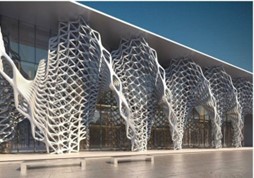
Some words have a ring to them, or whole strands of language seem easy to take in. Then language can almost be judged instantly, based on intuition, guts knowledge. A sense of self-evidence overcomes us, of something being straightforward, there is no need for side-steps, no need to look for further evidence. A statement may seem to carry its evidence within itself. ‘All bachelors are unmarried’ is but one example. It’s logical, unnecessary to explain, perfectly self-evident. This same sentiment can be simulated though. Not by relying on the meaning of what you are saying, but through the architecture of language, its structure.

One such technique used to produce a sense of self-evidence is the repetition of the same features in quick succession. This is called parallelism, a reference to the parallel lines within the architecture of language. Most effective when the same expression is repeated three times, it gives us a sense we do not need to appeal to further evidence, outside the realm of language. It feels as if evidence is embedded within language, dwells within its architecture. People utter three sentences, and each begins with the same phrase, as if constructing a parallelogram. For the listener there is a comforting drone of repetition, a recognition of sameness.
_____________
_____________
_____________
Language can indeed be convincing much like an Adidas logo elicits gut feelings. There are other linguistic features that play the same role though. The fluidity of speech matters, the speed of articulation as well as stylised intonation contours. This is not just about rhetoric, about persuasion but also about the architecture of language, the self-evidence hidden within its structure. As we begin to think about the architecture of language in greater detail, the notion of ‘forced’ perspective’ comes to the foreground. An appeal to intuition, guts knowledge, that resides in the form of language – not only its content – allows us to make such a comparison.

It was the 17th century Italian architect Francesco Borromini who created a masterpiece of forced perspective. Rows of column diminishing in size and a rising floor in the courtyard of the Palazzo Spada give an optical illusion of great depth. As if a life size sculpture features at the end of a long arcade. In reality it is only 24 inches high, the gallery a short 26 feet. A mathematician helped Borromini with his trick. As one of the famed illustrations of forced perspective this arcaded courtyard helps us to ask questions about the architecture of language. The forms that emulate the self-evident, are perhaps to be visualised as a false sense of depth? Such forms are different for each language, for each forced perspective adding interest to the study of the architecture of language.

References
Atlas Obscura: Borromini’s Perspective Gallery of Palazzo Spada, Rome, Italy (https://www.atlasobscura.com/places/borrominis-perspective-gallery-of-palazzo-spada)
Douglas, Mary (1999) [1975] Implicit meanings: Selected essays in anthropology. London, New York: Routledge.
Du Bois, John W. (1986). Self-evidence and ritual speech. In Wallace Chafe & Johanna Nichols (eds.), Evidentiality: The linguistic coding of epistemology, 313-336. New Jersey: Ablex Publishing Corporation.
Sharma, Pragya (2022). How Parametric Architecture is Reinterpreting Building Design (https://www.pinterest.co.uk/pin/428123508314526146/)
Quine, Willard Van Orman (1943). Notes on existence and necessity. Journal of Philosophy 40(5): 113-127.